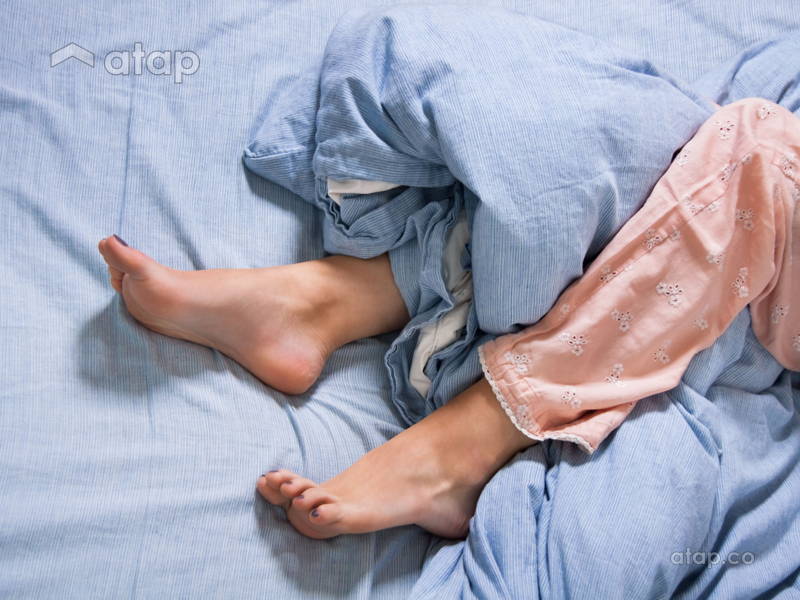Forget sleepless night on sweaty, scratchy sheets – we show you everything you need to know before buying them.
Nothing feels better than crawling back into your sheets after a long, hard day. Unless your bedding…sucks.
If you’re tossing and turning at night because your bed is a too-warm, too-scratchy inferno, here’s what you should be looking for in your next set of sheets.
Comfort and Quality
Thread count simply refers to the number of threads in a square inch of fabric. Sheets with a higher thread count are softer, thicker, and more durable – anything above 200 thread count will leave you a happy, pliable blob while 500 thread count and more will give you luxurious softness.
 Be warned though! Thick sheets can trap heat, so opt for sheets with a 200 – 400 thread count if your room tends to be warm. Some unscrupulous companies count fibres rather than threads so if the price tag on your 1,000 thread count sheets seems too good to be true, it probably is.
Be warned though! Thick sheets can trap heat, so opt for sheets with a 200 – 400 thread count if your room tends to be warm. Some unscrupulous companies count fibres rather than threads so if the price tag on your 1,000 thread count sheets seems too good to be true, it probably is.
Material is an important factor when deciding between sheet, so check the labels or ask the retail assistant fabout them.
Cotton sheets are the best in tropical weather! They’re breathable, wick moisture, and stay soft even after multiple washes. Look for Egyptian or Supima cotton; these are high quality long-fibre variations that produce softer, stronger sheets in contrast to short fibres which can feel coarse to the touch.
Ideally, your cotton should be ‘combed’. This is a process that’s only applied to better grades of cotton to produce finer yarns that last longer.

SOURCE: wohn-designtrend.de
Microfibres such as modal and Tencel are also great options; they’re just as soft and breathable, though modal is not as durable and Tencel can be pricy.
Steer clear of polyester and polyester blends. These usually have poor airflow, trap heat and moisture, and attract static electricity – night sweats and that buzzy feeling aren’t worth the dollars you save. Unlike cotton, stains also occur more easily on polyester and are harder to remove.
There are a number of different types of weaves, but the most popular in the sheet world are percale and sateen. If you’re looking for soft, silky sheets to serve as a backdrop for your after-hour activities, opt for sateen.
On the other hand, percale is crisp and cooler – great for our hot, sweaty nights. Percale also tends to be more durable than sateen which can tear and pill easily, especially if it’s of a low thread count. Unfortunately, percale wrinkles easily so weigh your choices carefully.
Up your sheets’ game by opting for sheets that have been treated! The most popular processes are:
Mercerizing: mercerising makes your sheets stronger and more absorbent. This also means they absorb more dye, so you get brighter, more vibrantly coloured sheets.
Easy care or wrinkle resistance: this treatment allows your sheets to dry smooth and crease-free so you spend less time ironing large squares of fabric.
Shrinkage control: this makes sure your sheets don’t shrink by more than 1 – 2%, regardless of the number of times you wash them.
Softener: to no surprise, softeners soften your fabric.
Do take note that most of these treatments involve the application of chemicals, so stay clear of poor quality manufacturers! Shrinkage control also tends to make sheets less cool and comfortable.
How do you identify poor sheet quality? Here are some ways:
- Hold up your sheet to the light – it won’t shine through sheets with a high thread count. You should also look out for unusually thick or thin areas that can be a sign of poor manufacturing.
- Scratch your sheets with your fingernails. If it fuzzes or pills, your weave isn’t great and your sheets may tear easily.
- Check corners and creases for undyed or poorly dyed areas. If you have printed or patterned sheets, check the seams to see if the pattern has been repeated at correct angles. You know the rule: if you can’t get the easy things right, you probably can’t get nothing right.
Pro-tip: we recommend having 2-3 sets of sheets for your personal bedroom and 1-2 for your guest room. This way you will always have an extra set when the other’s in the wash.
Style
Fitted sheets are a pain to fold, but they stretch across your mattress like a dream. For a smoother finish, look for sheets that have elastic all around rather than just in the corners.

SOURCE: decor-ideas.info
Be sure to measure your mattress before you make your purchase! Other than size – single, twin, queen, king, etc. – take note of your mattress height to make sure your fitted sheet’s pockets are deep enough to accommodate it.
Bright patterns and colours add a warm splash to thehttps://atap.co/malaysia/en/ideas/bedroom bedroom, but can be overwhelming when your brain is trying to shut down and go to sleep. Soft neutrals and pastel colours provide a restful alternative, but do not conceal stains easily. Figure out a balance that works best for you; we also like earthy colours like blue and green.

SOURCE: 7solutionsresponse.org
Check out our article on colour psychology to learn more about how colours can affect your mood.
Add texture to your sleeping arrangement with sheets that have ruching or pintucks – bonus points for the fact that your wrinkles will look intentional! You can also mix and match throw pillows, blankets, and other accessories to liven up your look.

SOURCE: decorist.com
Forget sleepless night on sweaty, scratchy sheets – we show you everything you need to know before buying them.
-
 Atap DesignVoyage 2024: A Day of Design Discovery and Connection
Atap DesignVoyage 2024: A Day of Design Discovery and Connection
-
 6 Designers Share Lessons They Learned from Their Mothers
6 Designers Share Lessons They Learned from Their Mothers
-
 The Art of Personalisation: How King Living Creates Unique Furniture with Modular Design
The Art of Personalisation: How King Living Creates Unique Furniture with Modular Design
-
 Best Condos for Young Professionals in Klang Valley
Best Condos for Young Professionals in Klang Valley
-
 Give Your Home A Designer Touch with Rugsea
Give Your Home A Designer Touch with Rugsea









